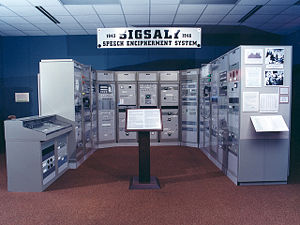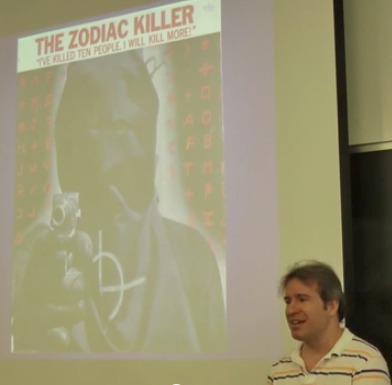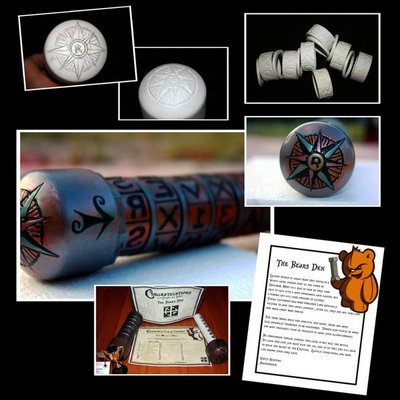2013 Cryptologic History Symposium
I had the pleasure of attending this year’s Cryptologic History Symposium, held on Oct 17 and 18 in Laurel, Maryland. The event is organized every two years by the non-profit foundation that supports the NSA’s National Cryptologic Museum.

The proceedings were filled with dozens of fascinating talks by noteworthy professionals in the world of cryptology, and I met several interesting and colorful personalities. Here are some highlights.
NSA Deputy Director John C. Inglis kicked off the symposium with his keynote talk, in which he spent a lot of time defending the NSA in light of the numerous unauthorized disclosures by Edward Snowden of the NSA’s secret and controversal surveillance programs.

York University professor Craig Bauer told a fascinating tale about famed computer scientist Alan Turing’s work on SIGSALY, a telephone voice scrambling machine developed during World War II. Created before the digital age, the machine was humongous and required carefully protected phonograph disks to store the cryptographic keys consisting of random noise.


I spoke with Dr. Bauer and learned that he had included the Zodiac Killer in an interesting talk he gave about famous unsolved codes and ciphers. He’s also working on an upcoming book about this topic. Videos of his talk are available on Youtube:
Click this link to go directly to the Zodiac portion of his talk which starts 12 minutes and 32 seconds into the video. He gives a brief summary of the case, and touches on Gareth Penn’s radian theory and the New York Zodiac copycat killer Heriberto Seda.

He even gave Heriberto Seda’s cryptogram as an exercise for students of York’s cryptology course.

At the conference I also met German cryptology author Klaus Schmeh, who writes an interesting German-language blog about various cryptologic mysteries, including the Zodiac ciphers. His book Nicht Zu Knacken (which I wrote about here) has a chapter devoted to the Zodiac ciphers. At the conference, Klaus gave a talk about compiling a list of 32 encrypted books. He showed some examples, ranging from obscure encrypted texts, to more well-known books such as the Voynich Manuscript and Codex Rohonci. He even brought his own hand-made reproduction of the Codex Rohonci as a prop for people to look through.
Video of Klaus’ talk (Part 1):
Video of Klaus’ talk (Part 2):
(The volume is faint, so you’ll need to crank up the volume on your speakers)
Video game developer, cryptology enthusiast and Kryptos expert Elonka Dunin gave a talk about the use of cryptology in the recreational activity of Geocaching. I was surprised to learn that many caches require solving cryptograms and other puzzles before you can learn the location of the caches. She told me that some of the puzzles remain unsolved. You can view them here. Some puzzles are even based on the German Enigma machine.

Dr. Todd Mateer spoke about his cryptanalysis of one of the Beale ciphers. In the original document, James B. Ward’s The Beale Papers, each number in the solved cipher corresponds to a word from the Declaration of Independence. Mateer tried to reconstruct the solution based on the procedure outlined in Ward’s paper. He found that he ran in to trouble due to the numerous variations of the Declaration of Independence that were published in Ward’s day. He also found that there are mistakes in the encipherment, such as duplicate numberings in the version of the DOI in Ward’s paper. How is it that the so-called Beale cipher uses the exact same DOI variant, and the exact same encipherment mistakes, as that of Ward’s decipherment? What are the chances that Beale and Ward made precisely the same mistakes? Mateer’s conclusion is that it’s because the Beale treasure is likely to be a hoax, invented by whomever authored The Beale Papers. Nick Pelling offers the alternate view that the oddities found in the unsolved Beale ciphers reflect a change in the encipherment procedure that causes bits of an encrypted key to show through. Some experiments in this direction might help clarify his idea.
The talk with the most attention-grabbing title was Shame, Sex and Alcohol: Ciphers in the Context of Everyday Practices of Secrecy in Early Modern Times, about encrypted messages left by noteworthy Hungarian historical figures in diaries and correspondences. Here is one of the more colorful excerpts:

The conference was very educational, provoking a thirst for more knowledge and discovery. I don’t want to miss the next one in 2015!